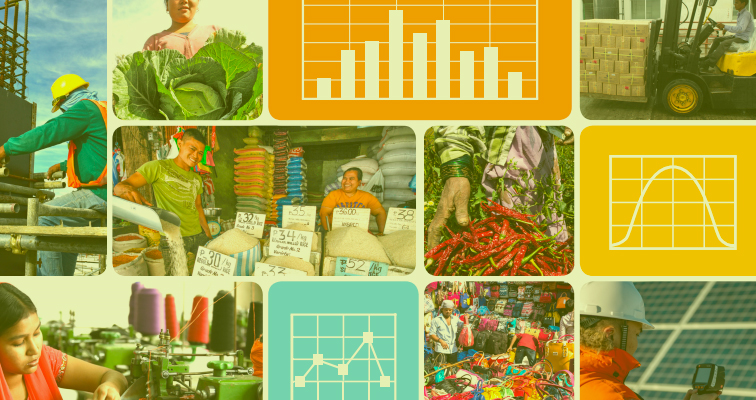The ICP is the world's largest global statistical initiative for estimating purchasing power parities (PPPs) to compare economic outputs, standards of living, and relative price levels across economies.
The ICP entails estimating PPPs and related macro-economic aggregates of economies for comparison. The World Bank coordinates global-level ICP, while ADB covers the program’s Asia and the Pacific component.

In December 2025, the Asian Development Bank (ADB) has released the Key Indicators for Asia and the Pacific 2025: Special Supplement—Enhancing Global Comparability: Asia and the Pacific in the International Comparison Program. This report highlights the importance of economic indicators based on the purchasing power parities (PPPs) produced by the International Comparison Program (ICP). These indicators enable international comparisons for policymaking, research, and tracking development goals. Drawing on the global ICP results, the report presents comparative analysis of living standards and price levels in Asia and the Pacific in the context of the global economy. «See more
The report marks 20 years of leadership by the Asian Development Bank (ADB) as the regional implementing agency for the ICP in the Asia and Pacific region. It outlines refinements in methodology and notes how producing these statistics of regional and global public value has strengthened capacity and enhanced collaboration among participating economies in Asia and the Pacific.
The full report is now available for download. «See less

The Asian Development Bank released the estimates of purchasing power parities (PPPs) and PPP based macro-economic aggregates of economies for the 21 participating economies in the 2021 International Comparison Program for Asia and the Pacific. Detailed tables are now available on this website and in https://www.adb.org/what-we-do/data/icp. Revised results of the previous benchmark year, 2017, are also available in these sources. Analyses of the key results from the 2021 ICP in the region can be explored in the newly launched report on the 2021 International Comparison Program in Asia and the Pacific, which is now available for download. «See more
The 2021 ICP in Asia and the Pacific was coordinated by the Asian Development Bank (ADB), as the regional implementing agency. ADB worked closely with 21 participating economies of the region and the ICP global office at the World Bank, under the guidance of the ICP Technical Advisory Group and the Regional Advisory Board for Asia and the Pacific. The 21 economies participating in the 2021 ICP in Asia and the Pacific are Bangladesh; Bhutan; Brunei Darussalam; Cambodia; the People’s Republic of China; Fiji; Hong Kong, China; India; Indonesia; the Lao People’s Democratic Republic; Malaysia; Maldives; Mongolia; Nepal; Pakistan; Philippines; Singapore; Sri Lanka; Taipei,China; Thailand; and Viet Nam.
The 2021 ICP for Asia and the Pacific provides economists, national policy makers, international organizations, and other stakeholders with PPPs of currencies, price levels, and real and per capita expenditures for GDP and its several expenditure components for 21 participating economies, with Hong Kong, China as the reference economy and Hong Kong dollar as the reference currency. The full set of results for the 2021 cycle is available online and includes data for GDP and 44 sub-aggregates along with the revised results for the 2017 ICP benchmark. The revised 2017 ICP results are for 22 economies that participated in the 2017 ICP cycle. These include the above 21 economies that participated in the 2021 ICP and Myanmar.
The 2021 ICP in Asia and the Pacific mainly followed the methodology used in the 2017 cycle, with one innovation: a new methodology developed by ADB for comparing price levels and real expenditures in housing. With this methodology, Asia and the Pacific moved to the standard ICP approaches for housing comparisons based on housing rental and quantity data, suitably adopted to account for substantial differences in quality of dwellings across regional economies. It represents a notable advancement from the ad hoc reference volume approach used in previous rounds of ICP in the region. Following extensive testing and endorsement by the ICP Technical Advisory Group and the Regional Advisory Board, this method was implemented in the 2021 cycle and in the revisions of the 2017 results. Additional relevant information in each table is available in the notes sheet.
PPPs are statistical estimates and are subject to sampling and other measurement errors. Caution needs to be exercised in using PPP-converted real expenditures for ranking of economies when the differences in real expenditures between economies are small. Further, PPPs are meant for spatial comparisons of real expenditures for the given benchmark year and should not be used to directly make temporal comparisons. PPPs should also not be used to make any judgment on the overvaluation or undervaluation of a currency.
The successful completion of the 2021 cycle is largely due to the unwavering commitment of implementing agencies in the participating economies, and the innovative strategies adopted by ADB to coordinate the program and address data quality concerns through rigorous and transparent data validations. «See less
When estimated from expenditure side, GDP is total value of the final consumption of households, nonprofit institution serving households, and general government, gross capital formation plus balance of exports and imports.
| Economy |
|---|

Know the program, understand the concept of PPP, and stay updated with the latest events of ICP in Asia and the Pacific.
Review History Read Methodology View Events
View PPPs and other ICP indicators for various expenditure categories of the 22 participating economies in Asia and the Pacific.
Browse all ICP Data View Detailed Tables
Analyses of Key Results from the 2021 ICP for Asia and the Pacific can be explored in the newly launched Summary Report.
Read 2021 ICP Report View all Reports